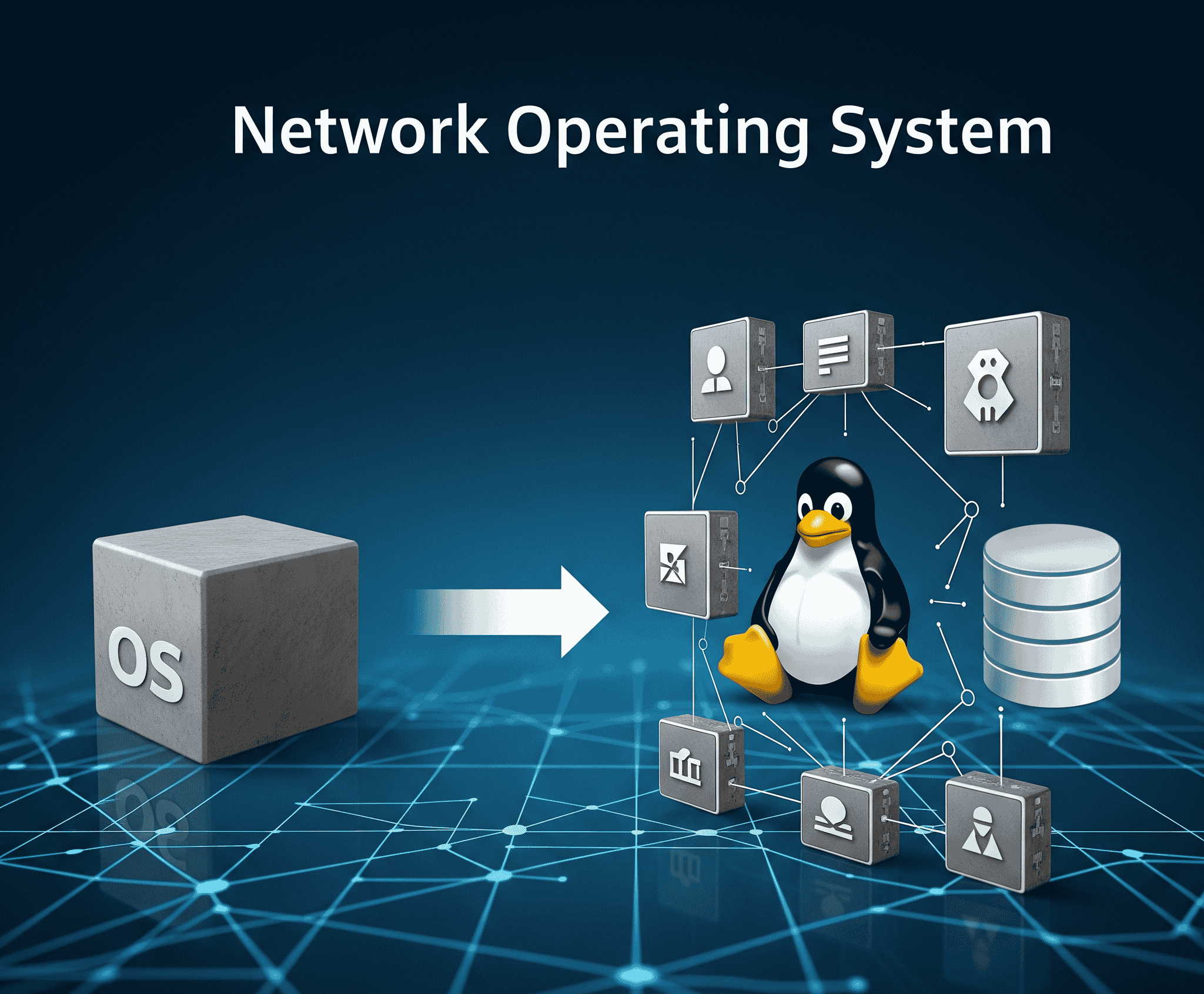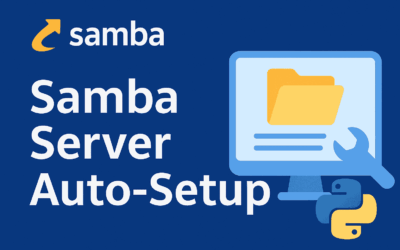Introduction
In the rapidly evolving landscape of network infrastructure, the operating system at the heart of our devices plays a pivotal role. For decades, Cisco IOS has been synonymous with robust, reliable networking. However, as networks grow in complexity, scale, and the demand for automation intensifies, the underlying architecture must also evolve. This blog post takes a visual journey through the significant architectural shifts of Cisco IOS, culminating in the highly advanced and open Cisco IOS XE 16.x. We’ll explore how this evolution moved from a traditional monolithic design to a modular, Linux-based platform, bringing forth unparalleled benefits in terms of stability, programmability, and operational efficiency. Get ready to dive into the core of what makes modern Cisco networking tick!
The Evolution of Cisco IOS Architecture: From Monolithic to Open
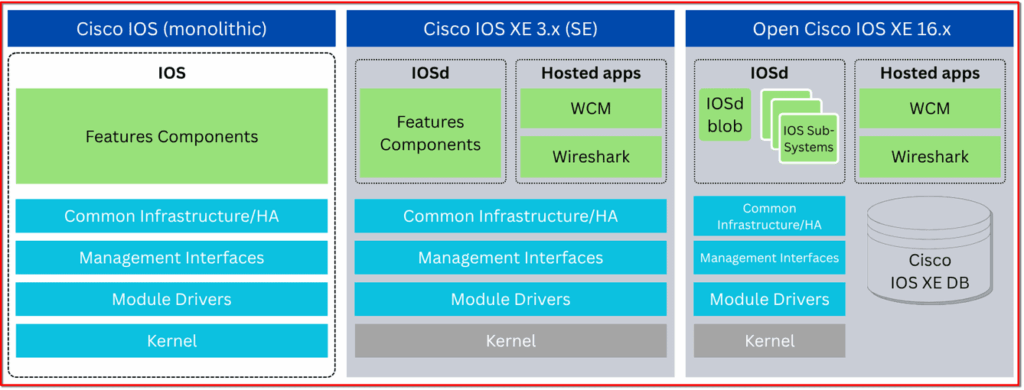
Cisco’s Internetwork Operating System (IOS) has been the backbone of networking for decades. Over time, its architecture has evolved significantly to meet the demands of modern networks, moving from a single, tightly integrated system to a more modular and open platform. Let’s break down the key architectural shifts.
1. Cisco IOS (monolithic)
This represents the traditional, classic Cisco IOS. It’s a monolithic architecture, meaning all components are tightly coupled and run as a single, large program.
- IOS (Features Components): This green block encompasses all the networking features and functionalities (routing protocols, switching, security, etc.) built directly into the IOS. Everything is bundled together.
- Common Infrastructure/HA: Handles shared services and high availability features.
- Management Interfaces: Provides ways to configure and monitor the device (e.g., CLI, SNMP).
- Module Drivers: Low-level software that interacts with the hardware modules.
- Kernel: The core of the operating system, directly managing the hardware resources.
In this model, any change or new feature often required a complete IOS upgrade, and a problem in one component could potentially affect the entire system.
2. Cisco IOS 3.X (SE)
This architecture represents a step towards modularity, often seen in platforms like the Cisco ASR 1000 series. While still largely integrated, it introduces the concept of separating the core IOS functions from certain hosted applications.
- IOSd (Features Components): The “IOS Daemon” is still the core IOS, containing the essential networking features. The “d” signifies that it runs as a separate process.
- Hosted apps: This is a significant addition. It allows certain applications, like WCM (Web Call Manager) and Wireshark, to run independently alongside the IOSd. This provides more flexibility and prevents these applications from directly impacting the core IOS operation.
- Common Infrastructure/HA, Management Interfaces, Module Drivers, Kernel: These layers remain similar in function to the monolithic IOS but are now supporting a more modular upper layer. The kernel is likely still a tightly integrated part of the system.
This design improved stability by isolating some applications and allowed for more targeted updates for hosted apps without always touching the core IOSd.
3. Open Cisco IOS XE 16.X
This is the most modern and open architecture, exemplifying a significant shift towards a Linux-based, highly modular, and extensible operating system. Cisco IOS XE is designed to run on a variety of hardware and supports virtualization and containerization.
- IOSd (IOSd blob, IOS Sub-Systems): The core IOS functionality is still present as “IOSd,” but it’s now often referred to as a “blob” or broken down into “sub-systems,” indicating a further level of modularity and potentially running as containers or processes within a Linux environment.
- Hosted apps (Container, 1K Eyes, Wireshark): This layer is significantly enhanced. Applications are now often run in containers, offering much stronger isolation, portability, and easier deployment. Examples like 1K Eyes (Cisco’s embedded monitoring tool) and Wireshark can leverage this containerized environment.
- Common Infrastructure/HA, Management Interfaces, Module Drivers: These layers abstract the underlying hardware and provide interfaces for the various software components.
- Cisco IOS XE DB: A crucial addition! This signifies a central database where configuration and operational data are stored. This separation of data from the running processes is key for programmability, automation, and real-time telemetry.
- Kernel: Underneath it all is a Linux kernel. This is the biggest architectural change, as it provides a robust, open-source foundation upon which all other components (IOSd, hosted apps) run. This allows Cisco IOS XE to leverage the vast ecosystem of Linux tools and services.
This open architecture enables greater programmability, automation, network slicing, and the ability to easily integrate third-party applications, making Cisco IOS XE a powerful platform for next-generation networks.
The Significance of Cisco IOS XE DB (Crimson):
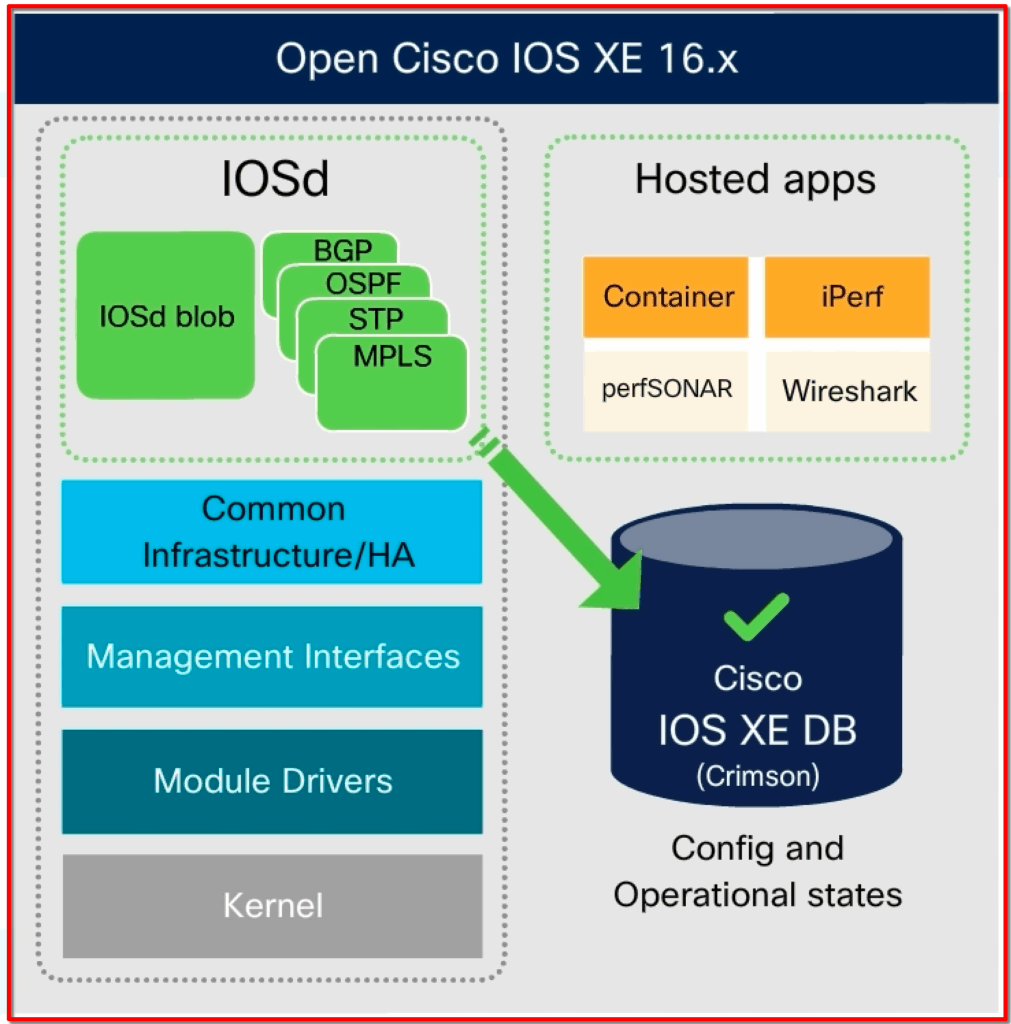
The most prominent new element in this diagram is the Cisco IOS XE DB (Crimson). This represents a fundamental shift in how configuration and operational data are handled:
- Centralized Database: Instead of configuration and state information being scattered across various processes or volatile memory, it’s now stored in a centralized, persistent database. This database is often referred to by its internal codename, Crimson.
- “Config and Operational states”: This database holds both the intended configuration (what the network device should be doing) and the actual operational state (what the network device is currently doing).
- Decoupling of Data: The green arrow pointing from “Common Infrastructure/HA” to the “Cisco IOS XE DB” signifies that core system components interact with this database to retrieve and store information. This decouples the data from the running processes, meaning configuration changes can be atomic, validated, and rolled back more easily. It also facilitates streaming telemetry and programmatic access to device state.
Key Benefits and Features
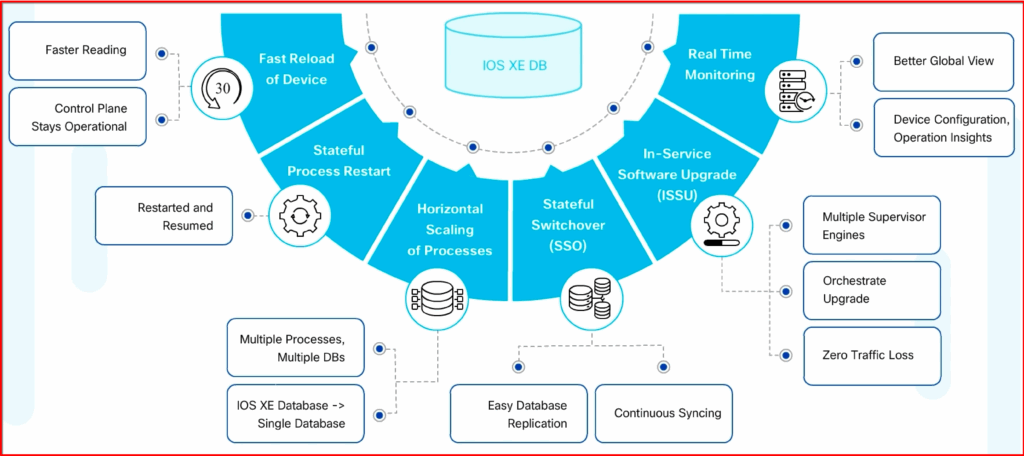
This diagram highlights the significant advantages and underlying mechanisms of Cisco IOS XE, all pointing towards enhanced reliability, faster operations, and improved monitoring. The IOS XE DB (database) serves as a central hub enabling many of these capabilities.
Let’s break down the main concepts:
1. Fast Reload of Device
- Control Plane Stays Operational: Crucially, the routing and control plane functions can continue to operate even during a process restart, preventing network outages.
- Faster Reading: This implies quick retrieval of necessary information for the restart from the persistent database.
2. Stateful Process Restart
- Stateful Process Restart: Instead of a full device reload when a process crashes or needs restarting, IOS XE can restart individual processes while maintaining their operational state.
- Restarted and Resumed: This means the process can pick up where it left off, minimizing disruption.
3. Horizontal Scaling of Processes
- Multiple Processes, Multiple DBs: In traditional systems, each process might have its own small, isolated data store.
- IOS XE Database -> Single Database: With IOS XE, the architecture shifts to a single, centralized database (the IOS XE DB). This allows for:
- Easy Database Replication: The central database can be easily replicated for redundancy and performance.
- Continuous Syncing: Data across the system and its components is continuously synchronized with this central database.
This central database approach simplifies data management and provides a consistent view of the network state, paving the way for better scalability and resilience.
4. Stateful Switchover (SSO)
- Stateful Switchover (SSO): This is a critical high-availability feature for devices with redundant supervisor engines.
- When the active supervisor fails, the standby supervisor takes over seamlessly without losing the established network sessions and states. This is possible because the standby supervisor maintains synchronized state information with the active one.
5. In-Service Software Upgrade (ISSU)
- In-Service Software Upgrade (ISSU): This enables upgrading the IOS XE software (or specific components) on a device without any downtime or traffic loss.
- Zero Traffic Loss: This is the ultimate goal of ISSU, ensuring continuous network operation during upgrades.
- Multiple Supervisor Engines: ISSU typically relies on the presence of redundant supervisor engines (like in SSO) to facilitate the upgrade process, switching traffic between them.
- Orchestrate Upgrade: The system can orchestrate the upgrade process, managing the transition between old and new software versions on the different supervisors.
6. Real Time Monitoring
- Real Time Monitoring: IOS XE’s architecture, especially with the central database, allows for continuous, real-time collection of operational data and telemetry.
- Better Global View: This provides administrators with a comprehensive and up-to-date view of the entire network’s health and performance.
- Device Configuration, Operation Insights: The collected data offers deep insights into device configurations, their current operational status, and potential issues, facilitating proactive management and troubleshooting.
Final Thoughts
As we’ve journeyed through the architectural evolution of Cisco IOS, from its monolithic roots to the sophisticated Open Cisco IOS XE 16.x, the direction is clear: modularity, openness, and data-driven intelligence are paramount.
The transition to a Linux-based kernel, the isolation of core IOSd functions, and the ability to host containerized applications mark a profound shift. This architecture isn’t just about running network protocols; it’s about creating a robust, flexible, and extensible platform. The introduction of the Cisco IOS XE DB (Crimson) as a central repository for configuration and operational states is a game-changer. It underpins the ability to perform stateful process restarts, achieve hitless In-Service Software Upgrades (ISSU), and enable real-time monitoring with a comprehensive global view – all critical for maintaining network uptime and agility in today’s demanding environments.
Ultimately, Cisco IOS XE’s architectural advancements are about more than just incremental improvements; they represent a fundamental reimagining of what a network operating system can be. By embracing an open, modular design that leverages a central database and a robust Linux kernel, Cisco has laid a powerful foundation for enhanced automation, seamless integration with orchestration tools, and a future where network infrastructure is not just reliable, but also incredibly intelligent and adaptable. This evolution ensures that Cisco devices remain at the forefront of powering the next generation of digital transformation.

